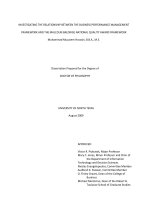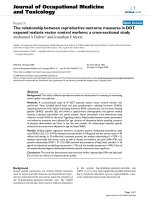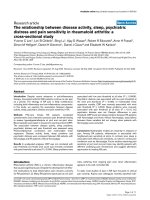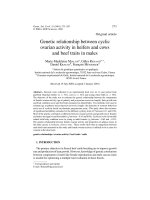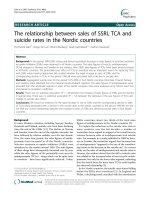Relationship between levels of dioxin in food and blood in some areas of Vietnam
Bạn đang xem bản rút gọn của tài liệu. Xem và tải ngay bản đầy đủ của tài liệu tại đây (131.26 KB, 6 trang )
JOURNAL OF MILITARY PHARMACO-MEDICINE N09-2017
RELATIONSHIP BETWEEN LEVELS OF DIOXIN IN FOOD AND
BLOOD IN SOME AREAS OF VIETNAM
Vu Tung Son*; Doan Huy Hau*
Vu Chien Thang*; Ha The Tan*
SUMMARY
Objectives: To assess levels of dioxin in food and human blood and determine the
relationship between levels of dioxin in food and human blood in some areas of Vietnam.
Subjects and method: A cross-sectional study on 108 human blood samples including males
and females, 33 samples of chicken, 33 samples of pork and 33 samples of fish were collected
at 33 sites in 16 provinces. Samples were then quantified with high resolution gas
chromatography mass spectrometry (HRGC/HRMS) by the U.S. EPA 1613 B. Result: Levels of
dioxin in blood in the sprayed area was (10.34 pg/g lipid) higher than in the unsprayed area
(6.94 pg/g lipid) with p < 0.05. The levels of dioxin in blood in the dioxin-contaminated area was
(9.62 pg/g lipid) higher than in the non-contamination area (8.24 pg/g lipid) with p < 0.05.
For food, chicken had the highest dioxin content. Chicken and pork were positively correlated
with dioxin content in human blood. Conclusion: Levels of dioxin in blood in the area sprayed
with herbicides was higher than in the unsprayed area. Similarly, they were higher in the dioxin
contamination than in the non-contamination area. Chicken and pork have positive corelation
with dioxin content in human blood.
* Keywords: Dioxin; Dioxin in food; Dioxin in blood; Relationship.
INTRODUCTION
Persistent organic pollutants (POPs)
include a group of pollutants that are
semi-volatile, persistent in the environment,
bio-accumulative and toxic for humans
and aminals. Two groups of POPs, namely
polychlorinated dibenzo-p-dioxins (PCDDs),
poly-chlorinated dibenzofurans (PCDFs)
and polychlorinated biphenyls (PCBs) are
persistently organic pollutants of great
concern because of their high toxicity and
tendency to bioaccumulate through the
food chain. These contaminants can be
formed as unintentional by products of a
number of chemical processes, as well as
in almost combustion process. More than
90 percent of dioxin penetrates the human
body through food. Therefore, the aim of
this study is: To evaluate the relationship
between levels of dioxin in food (chicken,
pork and fish) and those in blood in several
regions of Vietnam.
* Vietnam Military Medical University
Corresponding author: Vu Tung Son ()
Date received: 11/09/2017
Date accepted: 21/11/2017
152
JOURNAL OF MILITARY PHARMACO-MEDICINE N09-2017
SUBJECTS AND METHODS
Samples were selected based on the
characteristics of each region. The areas
1. Subjects.
- The first subject: People who have
lived in study area for at least 15 years
(no occupational exposure to dioxin), including
males and females. After that, they were
taken blood to quantify levels of dioxin.
were sprayed with herbicides during the
war (from the 17th parallel to the south,
which was encrypted “B”) and the area
was unsprayed with herbicides during the
war in Vietnam (from the 17th parallel to
the North, which was encrypted “A”).
- The second subject: Food (chicken,
In turn, each area was divided into those
pork and fish) which was collected at the
at risk of dioxin contamination, which was
same area; blood samples (food specimens
encrypted “1” (industrial production area
were collected in the lake or market).
or the area was sprayed directly with
Afterward, they were quantified levels of
herbicides) and those without dioxin
dioxin.
contamination, which was encrypted “0”.
2. Methods.
At each sampling point, each food was
33 samples of chicken, 33 samples of
taken from 6 to 10 specimens and then
pork, 33 samples of fish and 108 samples
were pulled to one sample. For blood
of blood were collected in 33 wards of
specimen, each person was taken 10 mL
16 provinces in Vietnam (Hoabinh, Hagiang,
whose blood samples were grouped by
Thainguyen,
age and gender.
Nghean,
Ninhbinh,
Quangtri,
Hue,
Thanhhoa,
Lamdong,
The sample size and sampling according
Kontum, Hochiminh City, Binhduong,
to US EPA (United States Environmental
Dongnai, Longan, Kiengiang, Angiang).
Protection Agency) guidelines.
Encode:
A
The area was not sprayed with herbicides during the war in Vietnam
B
The areas were sprayed with herbicides during the war
AB-0
Areas are non-dioxin contamination at both A or B
AB-1
Areas were at risk of dioxin contamination at both A or B
* Analysis:
Quantification 7 PCDD (polychlorinated dibenzo para dioxins) and 10 PCDF
(polychlorinated dibenzofurans) in blood and food by method US EPA 1613B, then
compute WHO TEQ concentrations (toxic equivalents).
153
JOURNAL OF MILITARY PHARMACO-MEDICINE N09-2017
RESULTS
Table 1: Levels of PCDD/F (TEQ) in blood by region.
TEQ (pg/g lipid)
Region
Number size
p-value
Min - max
X SD
A
36
3.26 - 26.96
6.94 ± 4.41
B
72
3.33 - 23.71
10.34 ± 4.76
108
3.26 - 26.96
9.21 ± 4.89
< 0.001
Total
Average TEQ was 9.21 pg/g lipid; average TEQ in blood at the areas which were
sprayed with herbicides during the war was 10.34 pg/g lipid higher significantly than the
area without herbicides in the same period (6.94 pg/g lipid) (p < 0.001).
Table 2: Levels of PCDD/F (TEQ) in blood by contaminated areas.
TEQ (pg/g lipid)
Feature
Numbers
p-value
Min - max
X ± SD
AB-0
32
3.26 - 26.96
8.24 ± 5.35
AB-1
76
3.33 - 23.71
9.62 ± 4.67
0.04
Average TEQ in blood in the area at risk of dioxin contamination (AB-1) was 9.26 pg/g
lipid, higher significantly than those without dioxin contamination (AB-0) (8.24 pg/g lipid)
(p < 0.05).
Table 3: Levels of PCDD/F (TEQ) in chicken, pork and fish by region.
TEQ (pg/g)
Food
Region
Numbers
Min - max
X SD
A
15
0.19 - 6.96
1.8 ± 1.9
B
18
0.53 - 13.5
4.41 ± 3.4
A
15
0.09 - 1.76
0.69 ± 0.49
B
18
0.28 - 4.51
1.33 ± 1.18
A
15
0.1 - 0.65
0.28 ± 0.16
B
18
0.16 - 0.79
0.29 ± 0.16
Chicken (pg/g lipid)
p
0.005
Pork (pg/g lipid)
0.07
Fish (pg/g wet weight)
0.4
Average TEQ in chicken, pork and fish in the areas sprayed with herbicides was
higher than those unsprayed with herbicides. However, only TEQ in chickens were different
significantly with p < 0.05.
154
JOURNAL OF MILITARY PHARMACO-MEDICINE N09-2017
Table 4: Levels of PCDD/F (TEQ) in chicken, pork and fish by contaminated areas.
TEQ (pg/g)
Food
Region
Numbers
p
Min - max
X SD
AB-0
11
0.4 - 6.96
2.3 ± 2.14
AB-1
22
0.19 - 13.5
3.69 ± 3.44
AB-0
11
0.09 - 1.55
0.64 ± 0.45
AB-1
22
0.22 - 4.51
1,25 ± 1.1
AB-0
11
0.1 - 0.59
0.26 ± 0.15
AB-1
22
0.13 - 0.79
0.29 ± 0.17
Chicken (pg/g lipid)
0.4
Pork (pg/g lipid)
0.08
Fish (pg/g wet weight)
0.6
Average TEQ in food in the area at risk of dioxin contamination (AB-1) was higher
than non-contamination dioxin area (AB-0). However, there was no significant
difference between the two regions with p > 0.05.
Table 5: Corelate Pearson between TEQ in chicken, pork and fish and TEQ in blood.
TEQ
Levels of dioxin
(pg/g lipid)
Chicken
Number
size
TEQ in blood
108
Pork
Fish
r
p
r
p
r
p
0.25
0.009
0.2
0.04
0.05
0.6
TEQ in blood were positively corelative to TEQ in chicken and pork (p < 0.05)
with r = 0.25 and 0.2, respectively.
Table 6: Correlate Pearson between TEQ in chicken, pork and fish and TEQ in
blood by region.
TEQ
TEQ in blood
by region
Number
Chicken
size
Pork
Fish
r
p
r
p
r
p
A
36
0.06
0.7
-0.03
0.8
0.38
0.02
B
72
0.15
0.19
0.15
0.2
-0.14
0.25
TEQ in blood were positively associated with fish at unsprayed areas (p < 0.05) with
r = 0.38.
155
JOURNAL OF MILITARY PHARMACO-MEDICINE N09-2017
Table 7: Correlate Pearson between TEQ in chicken, pork and fish and TEQ in
blood by contaminated areas.
TEQ
TEQ in blood by
contaminated areas
Number
size
Chicken
Pork
Fish
r
p
r
p
r
p
AB-0
32
-0.04
0.8
0.1
0.6
0.46
0.008
AB-1
76
0.3
0.008
0.2
0.08
-0.11
0.3
TEQ in blood were positively associated with fish at unsprayed areas (p < 0.05)
with r = 0.46 and chicken at sprayed area (p < 0.05) with r = 0.3.
DISCUSSION
The results showed that the content of
TEQ dioxin in our study was from several
times to dozens of times lower than that
in the study by the Hatfield Consultants
and Office of National Committee 33 in
Bienhoa Airport and Phucat Airport which
were reported in 2009 (5.64 - 8.350 pg/g
wet weight in fish) and 2011 (4.54 - 4,050 pg/g
wet weight in fish), respectively. Because
the samples in the study by Hatfield and
Office 33 were taken in the dioxin hotpot
[1, 2]. Compared with 187 studies by
Dario Consonni on 29,687 subjects from
26 countries in the world for 10 years
(1989 to 2010), our results were lower
than that his study (12.4 pg/g lipid) [3].
In terms of food, a monitoring study in
Latvia from the year 2009 - 2011 showed
that the TEQ content of chicken in both
sprayed and non-sprayed areas was
0.78 pg/g lipid, lower than that in our study
(4.41 and 1.8 pg/g lipid, respectively).
Specificially, TEQ content in all chicken
samples reached the allowable limit. As
for pork, the TEQ content in our study
156
was (0.28 pg/g lipid) also higher than that
in above study and no pork samples with
TEQ content exceeded the allowable limit.
For fish, the TEQ content in our study in
both regions was lower than fish specimens
in Baltic (2.25 pg/g lipid), but our results
were higher than fish samples in the
ocean (0.11 pg/g lipid). In the monitoring
study in Latvia, TEQ content in chicken
was higher than in other types of meat,
too [4].
Levels of dioxin in chicken, pork and
fish were related those in blood depending
on the region and characteristics. In particular,
the content of chicken and pork had a
statistically significant association with
levels of dioxin in blood. However, in terms
of characteristics, there was a positive
corelation between dioxin content in fish
and human blood in the areas unsprayed
with herbicides. When analyzing the
dioxin-contaminated characteristics, there
was a positive association between dioxin
concentration in fish and blood in the noncontaminated dioxin area, meanwhile in
dioxin-contaminated areas, there was also
JOURNAL OF MILITARY PHARMACO-MEDICINE N09-2017
a positive correlation between dioxin content
in chicken and human blood.
CONCLUSION
options for mitigating impacts. Hatfield Consultants
West Vancouver. British Columbia, Canada
and Office of National Committee 33, MONRE
Hanoi, Vietnam. 2009.
The level of dioxin in blood in the
sprayed areas was (10.34 pg/g lipid)
higher than in the unsprayed areas (6.94
pg/g lipid) (p < 0.001). The levels of dioxin
in blood in the dioxin-contaminated areas
was (9.62 pg/g lipid) higher than in the
non-contamination areas (8.24 pg/g lipid)
with p < 0.05. Chicken and pork have
positive correlation with dioxin content in
human blood.
2. Hatfield Consultants, Office of the
National Steering Committee 33, MONRE.
Environmental and human health assessment
of dioxin contamination at Bienhoa Airbase,
Vietnam. 200 - 850 Harbourside Drive, North
Vancouver, British Columbia, Canada V7P 0A3.
2011.
REFERENCES
4. Zacs D, Bartkevics V. Polychlorinated
dibenzo-p-dioxins, dibenzofurans and dioxinlike polychlorinated biphenyls in food and feed
in Latvia in 2009-2011. Food Additives &
Contaminants Part B, Surveillance. 2014, 7 (3),
pp.186-220.
1. Hatfield Consultants, Office of National
Committee 33. Comprehensive assessment of
dioxin contamination in Danang Airport, Vietnam:
Environmental levels, Human exposure and
3. Consonni D, Sindaco R, Bertazzi P.A.
Blood levels of dioxins, furans, dioxin-like PCBs,
and TEQs in general populations: a review.
1989 - 2010. Environment International. 2012,
44, pp.151-162.
157
